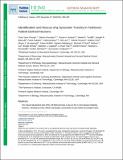Identification and Rescue of -Synuclein Toxicity in Parkinson Patient-Derived Neurons
Author(s)
Chung, Chee Yeun; Khurana, Vikram; Auluck, Pavan K.; Tardiff, Daniel F.; Mazzulli, Joseph R.; Soldner, Frank; Baru, Valeriya; Lou, Yali; Freyzon, Yelena; Cho, Sukhee; Muffat, Julien; Mitalipova, Maisam; Pluth, Michael D.; Jui, Nathan T.; Schule, Birgitt; Lippard, Stephen J.; Tsai, Li-Huei; Krainc, Dimitri; Jaenisch, Rudolf; Lindquist, Susan; Mungenast, Alison; Buchwald, Stephen Leffler; ... Show more Show less
DownloadTsai_Identification and rescue.pdf (4.979Mb)
PUBLISHER_POLICY
Publisher Policy
Article is made available in accordance with the publisher's policy and may be subject to US copyright law. Please refer to the publisher's site for terms of use.
Terms of use
Metadata
Show full item recordAbstract
The induced pluripotent stem (iPS) cell field holds promise for in vitro disease modeling. However, identifying innate cellular pathologies, particularly for age-related neurodegenerative diseases, has been challenging. Here, we exploited mutation correction of iPS cells and conserved proteotoxic mechanisms from yeast to humans to discover and reverse phenotypic responses to α-synuclein (αsyn), a key protein involved in Parkinson’s disease (PD). We generated cortical neurons from iPS cells of patients harboring αsyn mutations, who are at high risk of developing PD dementia. Genetic modifiers from unbiased screens in a yeast model of αsyn toxicity led to identification of early pathogenic phenotypes in patient neurons. These included nitrosative stress, accumulation of endoplasmic reticulum (ER)–associated degradation substrates, and ER stress. A small molecule identified in a yeast screen (NAB2), and the ubiquitin ligase Nedd4 it affects, reversed pathologic phenotypes in these neurons.
Date issued
2013-10Department
Massachusetts Institute of Technology. Department of Biology; Massachusetts Institute of Technology. Department of Brain and Cognitive Sciences; Massachusetts Institute of Technology. Department of Chemistry; Picower Institute for Learning and Memory; Whitehead Institute for Biomedical ResearchJournal
Science
Publisher
American Association for the Advancement of Science (AAAS)
Citation
Chung, Chee Yeun, Vikram Khurana, Pavan K. Auluck, Daniel F. Tardiff, Joseph R. Mazzulli, Frank Soldner, Valeriya Baru, et al. “Identification and Rescue of -Synuclein Toxicity in Parkinson Patient-Derived Neurons.” Science 342, no. 6161 (October 24, 2013): 983–987.
Version: Author's final manuscript
ISSN
0036-8075
1095-9203